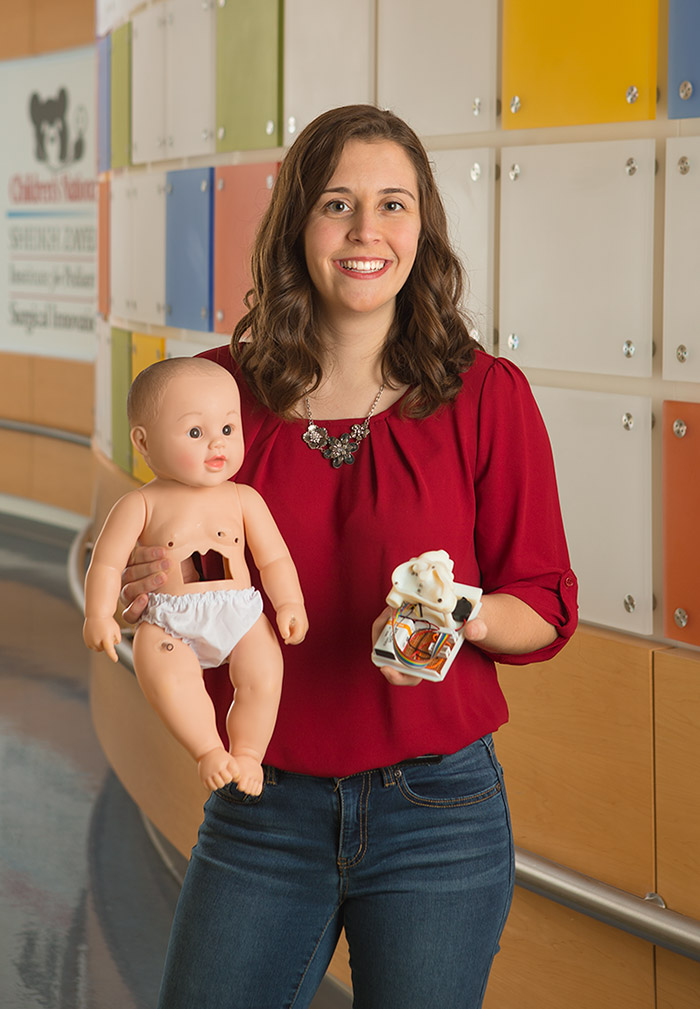With Her Heart and Mind

F
rom her laboratory within the Sheikh Zayed Institute for Pediatric Surgical Innovation at Children’s National Health System in Washington, D.C., Paige Mass (BME ’17) can see the SkyBear medical helicopter delivering critical patients, from infants to teenagers. While Mass is not likely to meet any one of them in person, she could conceivably change the lives of some of those patients through her design of a cardiac device specific to their individual needs. In a telephone interview from Children’s National, Mass, an R&D development operations engineer, recalls being allowed to observe a surgery in which one of her 3D-printed models was being tested.
“That was a huge moment for me, to see something go from my computer screen to the heart of a patient, and to know that it helped and made a difference,” she says. “I would like to someday see the devices I’m working on get FDA approval and become commercially available or the standard of care. If we can improve patient care through things like taking what is currently an open-chest, highly invasive procedure down to a small incision and see better outcomes for patients, that would be the dream.”
A self-described “legacy student,” Mass did not initially aspire to become an engineer even though her grandfather, father, brother, and an uncle all received engineering degrees from Illinois Tech. She considered becoming a pediatrician but thought that she might make greater contributions from the laboratory. Once at Illinois Tech, her biomedical engineering Senior Design course set Mass in a pivotal direction on her career path. She was a member of a team sponsored by Medline Industries that developed the NextGen Walker, a Medline ambulatory aid with an innovative hinge that allows the device to fold more easily and take up less space than models already on the market. One of her mentors was Michael Turturro (BME ’07, Ph.D. ’12), senior manager of research and development for Medline, the largest privately held manufacturer and distributor of medical supplies. Mass says that her opportunity to work on her senior design project under Medline’s expertise “set me up for success.”
“I learned a lot about designing a device while understanding the patient’s needs. On top of that, by working with Medline as a distributor, I got to know what the market is like and what the market needs,” she explains.
“That was a huge moment for me, to see something go from my computer screen to the heart of a patient, and to know that it helped and made a difference."
–Paige Mass
Last summer Mass herself became a mentor to an Illinois Tech student when Austeja Staneviciute (BME/M.S. CHE 4th Year) joined the Sheikh Zayed Institute lab through the Children’s National Summer Innovator Program. Staneviciute worked with Mass on a minimally invasive technique to implant epicardial pacemakers.
“It was an enriching experience to take my initially sketched ideas and build a prototype for phantom and animal-model testing,” she says. “Paige introduced me to a side of biomedical engineering that I never knew existed. I couldn’t believe that as an engineer I could be working so closely with doctors. One minute I was building a prototype with the engineers and then the next, I was discussing the potential benefits and complications of the medical device design with a clinician. Beyond the technical skills, Paige led by example on how to be an enthusiastic, resourceful, and empathetic engineer.”
Mass says that she’s “always had a spot in my heart for children” and adds that she quickly learned that in pediatric cardiology—her specialty area at Children’s National—kids are not simply miniature adults. That realization presents challenges.
“With adults you can expect more repeatability—a valve starts to fail or an artery gets blocked, there’s general wear and tear on the body,” Mass explains. “But kids are young; they aren’t supposed to get sick and when they do, it’s complicated not only by patient size but also by their unique problems. You can put a stent in an adult that is one size and that will probably work for them for the rest of their life, but with kids, you put in something that fits them now that they will outgrow. Or the device has a 20-year life expectancy when the child ideally has a lot longer.”
To address such challenges, Mass and her colleagues—one additional engineer and several clinicians—are investigating how they can use 3D printing to custom-design grafts that not only offer optimal design and fit but also can grow with the child over a lifetime. Mass is also designing a tool to fit onto a 3-millimeter-in-diameter catheter to assist in cardiac ablation. After observing that surgeons needed to pinch the tiny catheter for long periods while trying to insert it into even tinier heart vessels, Mass felt that a tool would both improve outcomes for the patient as well as prevent fatigue for those performing the procedure. Mass’s efforts have not gone unnoticed. Charles Berul, M.D., division chief of cardiology and co-director of the Children’s National Heart Institute, describes another project that she spearheaded.
“One in particular that she developed on her own is a simulation doll that can be used for trainees to practice manipulating catheters through the vascular system to key parts inside the heart, under direct visualization,” says Berul. “She designed the simulator herself, and we have tested it among students, cardiology fellows, and faculty cardiologists. She presented this work at a scientific conference last year, and it was enthusiastically received. She took the idea and ran with it from conceiving the idea to developing a model to testing it among a wide range of experienced users. The phantom simulation doll may help trainees practice before learning interventional cardiac procedures in people.”
For Mass, it is about never losing sight of the SkyBear landing pad outside of her laboratory window.